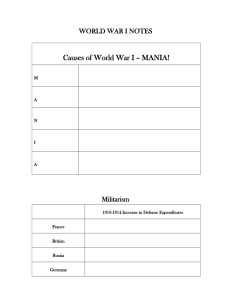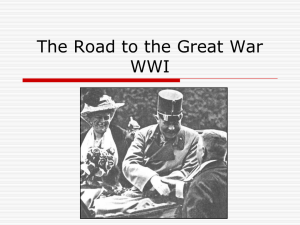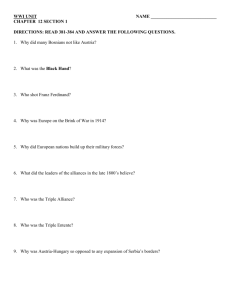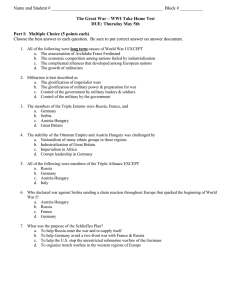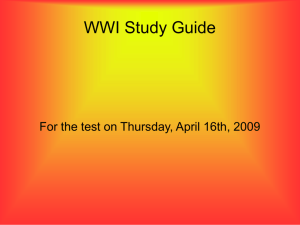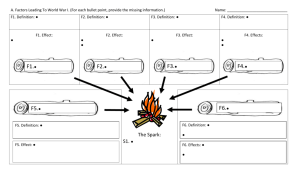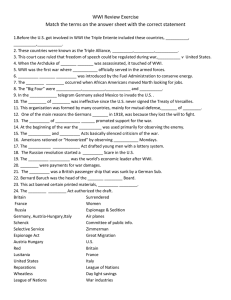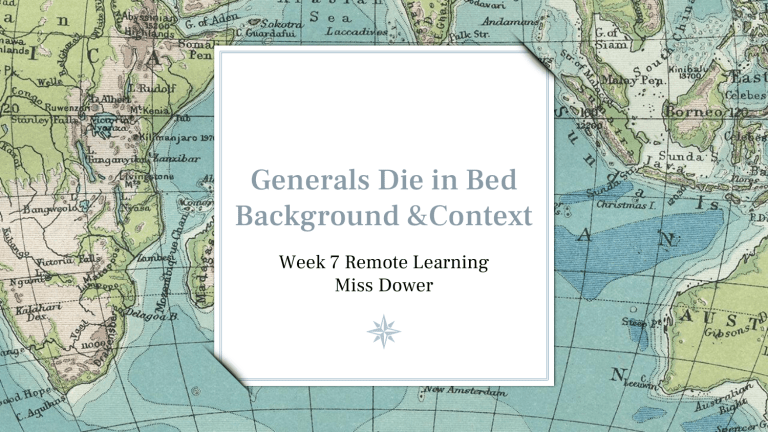
Generals Die in Bed Background &Context Week 7 Remote Learning Miss Dower What are we doing this week? LEARNING INTENTION: To gain an insightful understanding of the context of the text ‘Generals Die in Bed’ and the WWI era. SUCCESS CRITERIA: Students will answer questions to understand the context of WWI. 2 About the Author ➢ ➢ ➢ Charles Yale Harrison ➢ Fought as a machine-gunner in France and Belgium in WWI ➢ ➢ Born in Philadelphia in 1898 Enlisted with the Royal Montreal Regiment at the age of 19 Wounded at the Battle of Amiens in August 1918 and was repatriated Died in 1954, survived by his third wife 3 Context of WWI World War One (WW1) was a major global conflict that lasted four years, from 1914 to 1918. It became known as 'The Great War' because it affected people all over the world and was the biggest war anyone had ever known. Great Britain, Germany, Austria-Hungary and Russia all ruled many countries (colonies) across the world. They wanted to keep their empires strong and saw other countries taking over new territories as a threat. When Germany and Austria-Hungary took control of small countries like Bosnia and Morocco, the rest of the world thought they were being aggressive 4 On 28 June 1914, Archduke Franz Ferdinand, the heir to the throne of Austria-Hungary, was shot and killed by a Serbian man who thought Serbia should control Bosnia instead of Austria. Because its leader had been shot, Austria-Hungary declared war on Serbia. As a result: 1. Russia got involved because Russia had an alliance with Serbia. 2. Germany then declared war on Russia because Germany had an alliance with Austria-Hungary. 3. Britain declared war on Germany because of its invasion of neutral Belgium. Britain had agreements to protect both Belgium and France. 5 Who fought in the War? Many countries had made alliances and agreed to protect each other. If one was attacked, the others would defend them. So when war did break out in 1914, parts of Europe were already divided into two powerful groups. The opposing sides were: • The Triple Alliance - Germany, AustriaHungary and their allies • The Triple Entente - Great Britain, France and Russia (Italy changed sides and joined the Allies in 1915) *America entered the war in 1917 on the side of the Triple Entente 7 The Western Front 8 How did the War end? WWI ended on 11 November 1918 when the Allies and Germany signed a ceasefire, or 'armistice’, which is an agreement for peace that had been prepared by Britain and France. The image to the right depicts General Weygand, Admiral Wemyss and Marshall Foch after signing the armistice with Germany to mark the end of World War I. Universal History Archive/UIG/Getty Images In the end, there were 40 million military and civilian casualties. There were 20 million deaths and 21 million wounded. 9 How did this affect Australia? WWI is a vital part of Australia’s history. As part of the British Empire, Australia’s citizens were mostly of British descent. It was assumed that Australia would come to the assistance of the ‘Mother Country’. From a population of fewer than five million, 416,809 men enlisted A massive toll of 65% of Australian soldiers were killed or wounded, greatly harming the growing nation. Of the 60,000 Australian soldiers who died in battle, 48,000 died in France. 10 Review Questions 1. When was the First World War fought? 2. Which countries were involved in the war (Triple Alliance, Triple Entente and others)? 3. Where was the war fought? 4. When did the USA enter the war? 5. Who won and why? 6. What is the estimated death count of WWI? 11 Further Resources ➢ Armistice Day BBC: https://armistice-day.bbcrewind.co.uk/#/ Explore the online resource ‘Armistice Day’ created by the BBC. It takes a deep dive into the experience of WWI, including real accounts of people who were there. ➢ Crash Course Narrated by Ms. Norman: https://www.youtube.com/watch?v=qu0Qnv2jLbU&feature=youtu.be Listen as Ms. Norman narrates John Green’s Crash Course video on WWI to gain a deeper insight into the history and context of the era. 12

